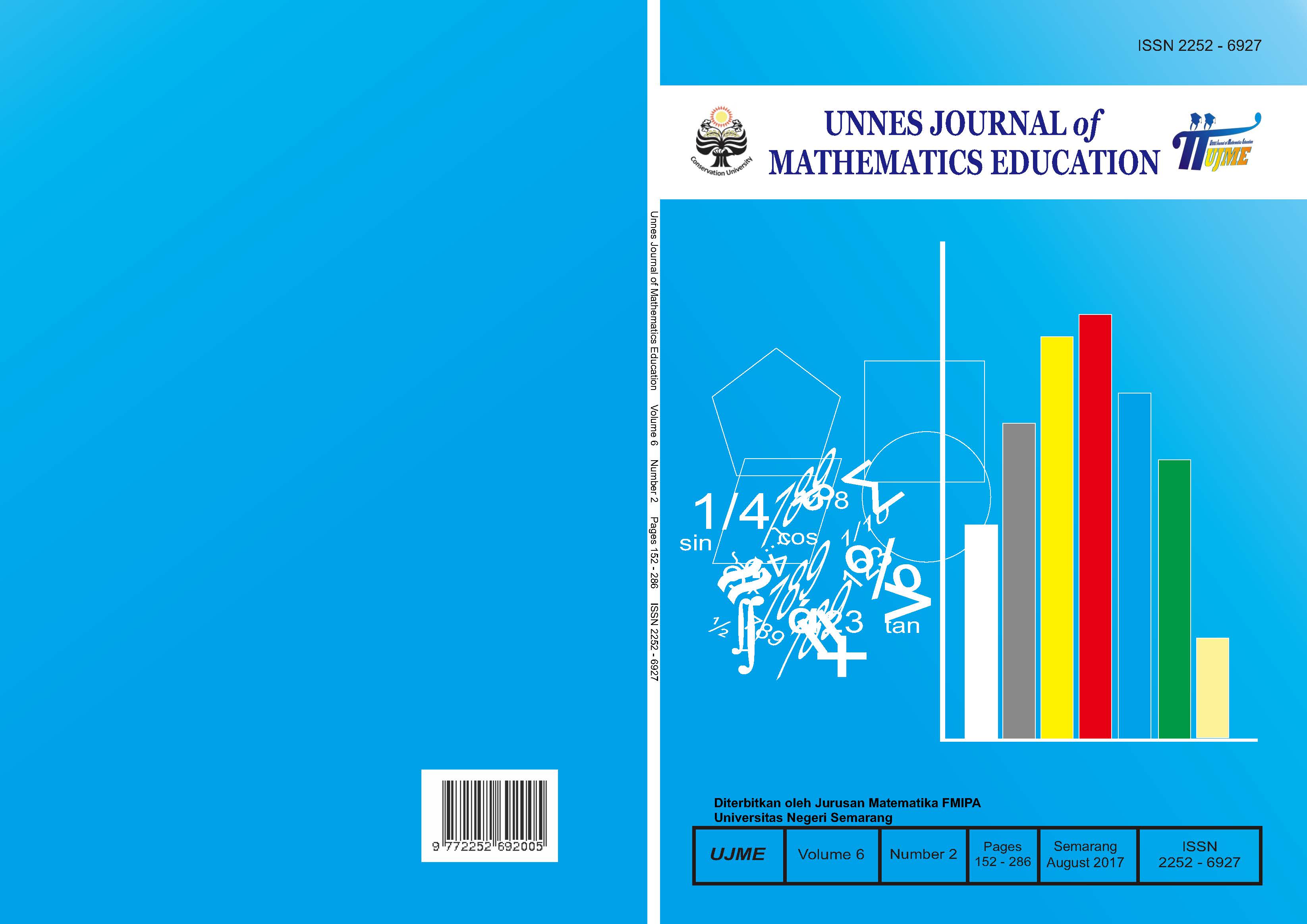High School Mathematics Curriculum Development Integrated with Character Education Within Project Assessment as Spiral System Leveled
##plugins.themes.academic_pro.article.main##
Abstract
The purpose of this research are: (1) description of characteristics and (2) validate thesenior hight school of mathematics syllabus integrated character education with the project assessment, (3) test the effectiveness of the learning material of function in class X. Testing procedure of syllabus and learning used research development of Borg & Gall (1987). The data were processed with descriptive analysis, statistical test t test and regression. The results obtained by the integration of the 10 characters on the senior hight school of mathematics syllabus show a valid syllabus by experts with an average score of 4 (both categories), the maximum score of 5. Test implementation on learning reach effective: (1) the percentage of learners achieve mastery learning by 89, 5%; (2) an increase of characters curiosity of learners of meeting 1 to 2, up to 3, up to 4 each score gain of 0.17; 0.30; 0.31; (3) the influence of the curiosity of students to the learning outcomes of 48.9%, (4) the average learning outcomes of students experimental class (77.2) is better than the control class (76.2). Thus, each character can bring a change in behavior according to the character programmed and observed in the learning process in focus. Coordination learning at every level stated in the syllabus.
##plugins.themes.academic_pro.article.details##
References
Asmani, J. M. (2013). Buku Panduan Internalisasi Pendidikan Karakter di Sekolah. Jogjakarta: Diva Press
Bas, G., & Beyhan, O. (2010). Effects of Multiple Intelligences Supported Project-Based Learning on Students Achievement Levels and Attitudes Towards English Lesson. International Electronic Journal of Elementary Education, 2(3): 366-368
Bas, G. (2011). Investigating The Effects Of Project-Based Learning on Students Academic Achievement and Attitudes Towards English Lesson. The Online Journal Of New Horizons In Education, 1(4): 1-15
Borg, R. W. and Gall M. D. (1987). Educational Research, An Introduction, Fourth Edition. New York: Longman.
Depdiknas. (2004). Panduan Penyusunan Kurikulum Tingkat Satuan Pendidikan Jenjang Pendidikan Dasar dan Menengah. Jakarat: BSNP.
Ekawati, E. (2011). Peran Fungsi Tujuan dan Karakteristik Matematika Sekolah. [Online] Tersedia di http://p4tkmatematika.org/2011/10/peran-fungsi-tujuan-dan-karakteristik-matematika-sekolah/
Endang & Nuryata. (2010). Pembelajaran Masa Kini. Jakarta: Sekarmita.
Hake, R. R. (1998). Interactive-engagement Versus Traditional Method: A Sixthousand-student Survey of Mechanics Test Data for Introductory Physics Course. Am. J. Phys. 66(1): 64-74.
Junaedi, I. (2014). Membangun Karakter Melalui Matematika dan Pembelajarannya. Makalah disajikan dalam Seminar Nasional dengan Tema: Peran Serta Cendekia Matematika dan Pendidikan matematika dalam Akselerasi Perubahan Bangsa, 8 November 2014.
Kemdiknas. (2010). Pengembangan Pendidikan Budaya dan Karakter Bangsa. Jakarta: Kemdiknas.
Kubiatko, M., & Vaculova, I. (2011). Project-Based Learning Characteristic and The Experiences with Application in The Science Subjects. Energy Education Science and Technology Part B: Social & Education Studies, 3(1): 65-75
Masriah, Sukestiyarno, Susilo, B.E. (2015). Pengembangan Karakter Mandiri dan Pemecahan Masalah melalui Model Pembelajaran MMP Pendekatan ATONG Materi Geometri. Unnes Journal of Mathematics Education, 4 (2): 163.
Masrukan. (2014). Asesmen Otentik Pembelajaran Matematika. Semarang: CV. Swadaya Manunggal
Rochmad. (2012). Desain Model Pengembangan Perangkat Pembelajaran Matematika. Jurnal Kreano. 3(1): 59-72.
Sudjana. (2005). Metode Statistika. Bandung: Tarsito.
Suherman, E., Turmudi, Suryadi, D., Herman, T., Suhendra, Prabawanto, S., Nurjanah, & Rohayati, A. (2003). Strategi Pembelajaran Matematika Kontemporer. Bandung: Universitas Pendidikan Indonesia.
Sukestiyarno. (2012). Statistika Dasar. Semarang: Universitas Negeri Semarang.
Sukestiyarno, Supartono, Lestari, W. (2014). Integration of Character Education On High School’s Subject Assited with School Laboratory. International Conference on Mathematics, Sciences, and Education. Semarang State University. Semarang.
Sumarni, W. (2015). The Strenghts and Weaknesses of The Implementation of Project Based Learning: A Review. International Journal of Science and Research (IJSR), 4(3): 478-484.
Tim Pengembang Kurikulum Unnes. (2012). Buku 3 Kuirkulum Unnes 2012 (Pendekatan, Strategi, Media, dan Evaluasi Hasil Belajar). Semarang: Tim Pengembangan Kurikulum Unnes.
Yudha, R.P., Masrukan, Djuniadi (2014). Pengembangan Instrumen Asesmen Otentik Unjuk Kerja Materi Bangun Ruang di Sekolah Dasar. Journal of Education Research and Evaluation, 3 (2): 63.
Wulandari, A.N., Sukestiyarno, Sugiman. (2013). Pengembangan Karakter dan Pemecahan Masalah melalui Pembelajaran Matematika dengan Model TAPPS. Unnes Journal of Mathematics Education, 2 (3): 45.
